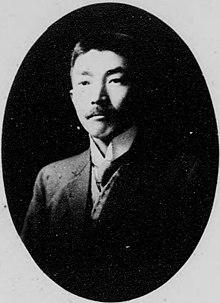Okada Shinichirō
Okada Shinichirō (岡田信一郎) (20 November 1883 – 4 April 1932) was a prominent Japanese architect who practiced in the early twentieth century.[1][2] Okada taught at Waseda University and Tokyo School of Fine Arts.[3]
Okada Shinichirō | |
|---|---|
 Okada Shin'ichiro | |
| Born | 20 November 1883 |
| Died | 4 April 1932 (aged 48) |
| Occupation | Architect |
While he was well-known for tendency for European styles, he also produced work in the Imperial Crown style (帝冠様式, Teikanyōshiki). One example is the Biwako Otsukan in Yanagasaki Lakeside Park, Shiga Prefecture.
Biography[edit]
On November 20, 1883 Okada was born in Tokyo. In 1900 he graduated from a middle school attached to the Normal School, which is now Tsukuba University secondary school/high school. He graduated from Daiichi High School in 1903 and entered the Tokyo Institute of Technology Technical University. He graduated from university in 1906.
After graduation Okada became a lecturer at Tokyo School of Fine Arts. In 1911 he became a lecturer at Waseda University, and became a full professor a year later in 1912. In 1923 he became a full professor at Tokyo School of Fine Arts.
Okada won the first prize in a design competition for the Osaka City Central Public Hall in 1917.[3] He designed the Tokyo Metropolitan Art Museum, a European classicist building with entrances on all four sides, which opened on 1 May 1926.[4] He also designed Meiji Seimei Kan, which was completed in 1934.
Okada died on April 4, 1932.
Selected works[edit]
- Komatsu Miyauchi Hinoshito statue pedestal base (1912)
- Bank of Japan Otaru Branch (1912) (currently a Financial Museum)
- Osaka City Central Public Hall (1917) Designed by Tatsuno Kataoka, based on Okada's original plan.
- Osaka Takashimaya (1921) Remodeled after war damage, demolished in 2007.
- Hatoyama Ichiro House ( 1924 ) Currently Hatoyama Kaikan.
- Kabukiza (1924) Restored after war damage but demolished in 2010.
- Aoyama Kaikan (1924). Constructed at the site of the residence of Suzumori Su-Feng.
- Tokyo Metropolitan Art Museum ( 1926 ). Demolished after the completion of the present museum.
- Tokyo Prefectural First Higher Girls' School (1927).
- Kokokuin Bago (1927) Kanoeiji Temple.
- Kamakura National Treasure Hall (1928): The temple shrine of Kamakura was heavily damaged by the Great Kanto Earthquake and was re-built.
- Kuroda Memorial Hall (1928):(黒田記念館)
- Tokyo Prefectural First Junior High School (1929). Current municipal Hibiya High School.
- Tokyo Art School Showroom (1929) Current Tokyo National University of Fine Arts and Sciences Department of Art College Showroom.
- Nikolaito repair (1930) of design by Mikhail Stichlupov.
- Hakuhodo (1930) Former headquarter building of the advertising agency. Demolished in 2010.
- Meiji Life Museum (1934)
- Lake Biwa Hotel (1934) Present Biwako Otsu pavilion.
-
Osaka Central Public Hall
-
Hatoyama Hall
-
Kuroda Memorial Hall
-
Tokyo Resurrection Cathedral
-
Hakuhodo
-
Meiji Yasuda Life Insurance Company Head Office
-
Biwako Otsukan
References[edit]
- ^ Nicolas Janberg, Chief Editor. "Shinichiro Okada (1883 - 1932)". Structurae. Retrieved 7 July 2017.
{{cite web}}:|author=has generic name (help) - ^ 明治生命館ご案内 (Guide to Meiji Seimei Kan). 2013-01-13.
- ^ a b "Original Museum Building by OKADA Shinichiro|TOKYO METROPOLITAN ART MUSEUM". Tobikan.jp. 1 May 1926. Retrieved 7 July 2017.
- ^ Masaaki Morishita (23 March 2016). The Empty Museum: Western Cultures and the Artistic Field in Modern Japan. Routledge. pp. 59–. ISBN 978-1-317-03418-6.







